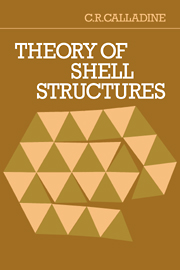Book contents
- Frontmatter
- Contents
- Preface
- List of symbols
- 1 Introduction
- 2 Generalised Hooke's law for an element of a shell
- 3 Cylindrical shells under symmetric loading
- 4 Purely ‘equilibrium’ solutions for shells: the membrane hypothesis
- 5 The geometry of curved surfaces
- 6 Geometry of distortion of curved surfaces
- 7 Displacements of elastic shells stressed according to the membrane hypothesis
- 8 Stretching and bending in cylindrical and nearly-cylindrical shells
- 9 Problems in the behaviour of cylindrical and nearly-cylindrical shells subjected to non-symmetric loading
- 10 Cylindrical shell roofs
- 11 Bending stresses in symmetrically-loaded shells of revolution
- 12 Flexibility of axisymmetric bellows under axial loading
- 13 Curved tubes and pipe-bends
- 14 Buckling of shells: classical analysis
- 15 Buckling of shells: non-classical analysis
- 16 The Brazier effect in the buckling of bent tubes
- 17 Vibration of cylindrical shells
- 18 Shell structures and the theory of plasticity
- Appendices
- Answers to selected problems
- References
- Index
5 - The geometry of curved surfaces
Published online by Cambridge University Press: 02 February 2010
- Frontmatter
- Contents
- Preface
- List of symbols
- 1 Introduction
- 2 Generalised Hooke's law for an element of a shell
- 3 Cylindrical shells under symmetric loading
- 4 Purely ‘equilibrium’ solutions for shells: the membrane hypothesis
- 5 The geometry of curved surfaces
- 6 Geometry of distortion of curved surfaces
- 7 Displacements of elastic shells stressed according to the membrane hypothesis
- 8 Stretching and bending in cylindrical and nearly-cylindrical shells
- 9 Problems in the behaviour of cylindrical and nearly-cylindrical shells subjected to non-symmetric loading
- 10 Cylindrical shell roofs
- 11 Bending stresses in symmetrically-loaded shells of revolution
- 12 Flexibility of axisymmetric bellows under axial loading
- 13 Curved tubes and pipe-bends
- 14 Buckling of shells: classical analysis
- 15 Buckling of shells: non-classical analysis
- 16 The Brazier effect in the buckling of bent tubes
- 17 Vibration of cylindrical shells
- 18 Shell structures and the theory of plasticity
- Appendices
- Answers to selected problems
- References
- Index
Summary
Introduction
The geometry of curved surfaces plays an important part in the theory of shell structures. Many practical shell structures are made in the form of simple surfaces such as the sphere, the cylinder and the cone, whose geometry has been well understood for centuries. It has, therefore, been argued by some workers that sophisticated geometrical ideas are not needed for the analysis and design of a wide range of practical shell structures.
Gauss (1828) made a breakthrough in the study of general surfaces. He showed that there were two completely different ways of thinking about a curved surface, either as a three-dimensional or a two-dimensional object, respectively; and that the two different views had a very simple mathematical connection involving a quantity which is now known as Gaussian curvature. The ideas which Gauss described in his paper are of great importance for an understanding of the behaviour of all shell structures, however simple their geometrical form happens to be. The main object of the present chapter is to explain Gauss's work in relation to the geometry of curved surfaces. In chapter 6 we shall proceed further along these lines, with an investigation of the geometry of distortion of curved surfaces.
The basic geometrical ideas which Gauss discovered are not difficult to grasp by those who have at their disposal relatively modest mathematical tools. However, Gauss gave a very thorough treatment of the problem in his paper, and in particular he developed the use of general curvilinear coordinates for the description of surfaces.
Information
- Type
- Chapter
- Information
- Theory of Shell Structures , pp. 124 - 150Publisher: Cambridge University PressPrint publication year: 1983
